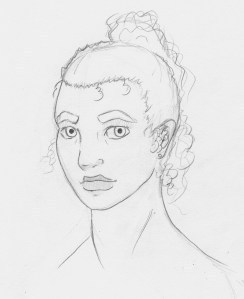The Sins of the Protagonist

Sketchy thing by MR Graham, competent writer and mediocre artist
I did something bad when I created Sandie, one of the main protagonists of The Siren. Something truly terrible.
I sat down and wrote.
I didn’t plan or plot or outline. Like The Hobbit, The Siren began with one sentence in my head that wouldn’t go away:
“There was a dead body on Sandie’s back porch, and it was trying to get in.”
I woke up one morning with that line in my head, scribbled it into my journal, and let it sit until writer’s block sent me scrounging for new inspiration.
It was a freewriting exercise. My sole intention was to get the juices flowing again so I could complete a different project – at that point, it was In the Shadow of the Mountains. So I started writing a story, and all I knew about it was that there was some sort of zombie thing and a person called Sandie. I didn’t know why the body was moving, who Sandie was, or even what genre this thing might fall under.
It worked out, though. Sleep seems to be when I’m most creative, and just like I had woken up with that opening line, I woke up a few weeks later with the story’s ending clear in my mind. I still didn’t know how I was going to get from Point A to Point B, but a music video (No, seriously, click that link and prepare to be flabbergasted.) and a very, very long car trip helped sort that out. By the end of the car trip, I knew what had to happen, I knew what was up with the dead body, and I had a grip on the central themes I wanted to incorporate.
I still didn’t know who Sandie was. By that time, though, Sandie was still my POV character, but the story was no longer about her dealing with zombies as it was about the relationship between her and the creature that inserted itself into her life.
So I did one of the worst things a writer can do. I plunged headfirst into a project without knowing a damned thing about one of the two most important players. She actually started out as an investigative reporter, rather than a marginally-interesting barista.
And it hasn’t mattered even a little bit.
I’ve seen all kinds of character interview sheets, hundreds or thousands of questions long, based on the assumption that a writer needs to know absolutely everything about the characters and the setting and the plot, and that’s a complete load of bull.
Fictional characters, like real people, are more than just a data set. Think about your best friend. You may not know how many people attended their sixth birthday party, and you don’t need to. You have a feel for them. That feel comes first; descriptors come later.
I had a feel for Sandie. I didn’t start out knowing much about her, but I felt like I knew her. I knew how she would react to finding a mobile corpse on her back porch, and so I took things backward and constructed a data set that would produce those reactions. I know people who get so hung up on characters’ backstories that they change their plots to suit – This character’s daddy issues wouldn’t let her do this thing I need her to do, so she’ll have to do something different. That can work, of course, but it can also result in deus ex absurdities being pulled out of thin air to get the plot back on track – or worse yet, a plot that meanders and backtracks and ultimately goes nowhere.
Work backward. Even in a character-driven story, the plot is what reveals the characters. If the plot goes somewhere the character doesn’t want to go, then the character isn’t really driving. Something needs a tweak.





